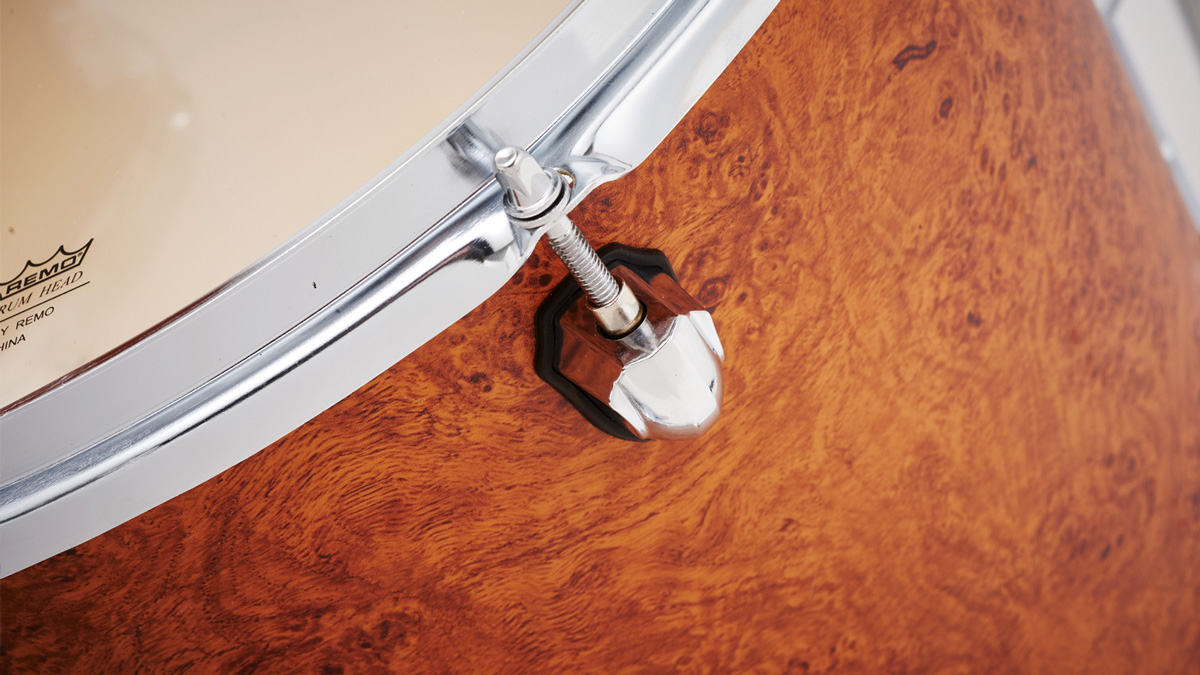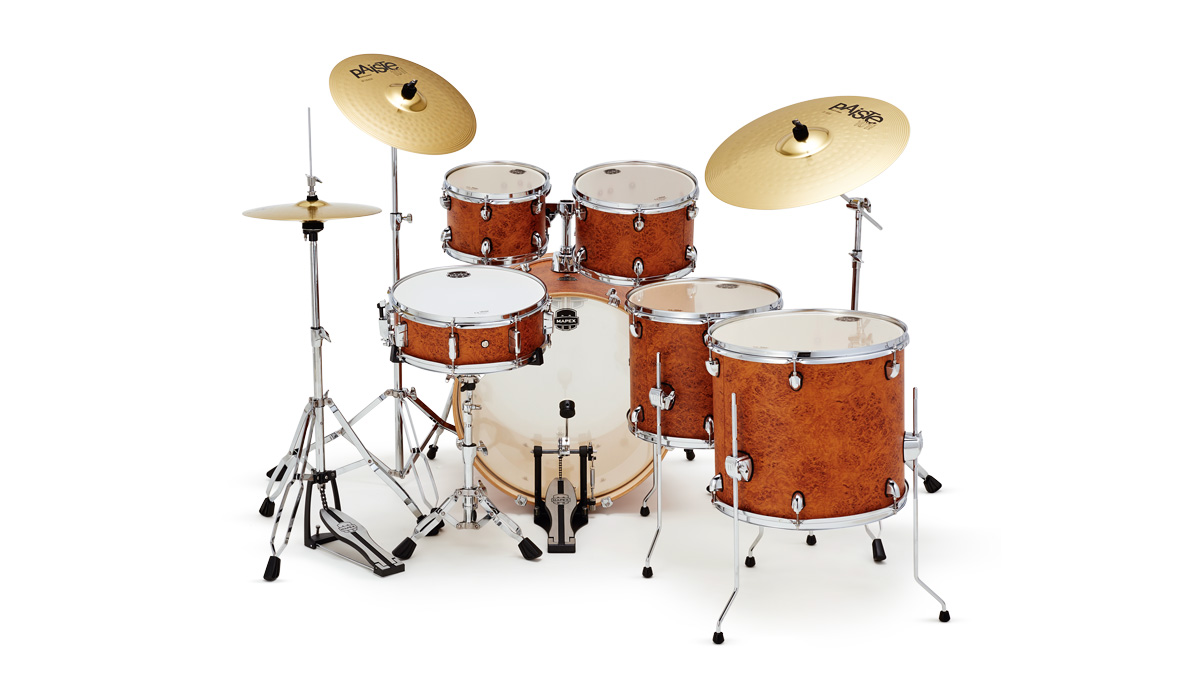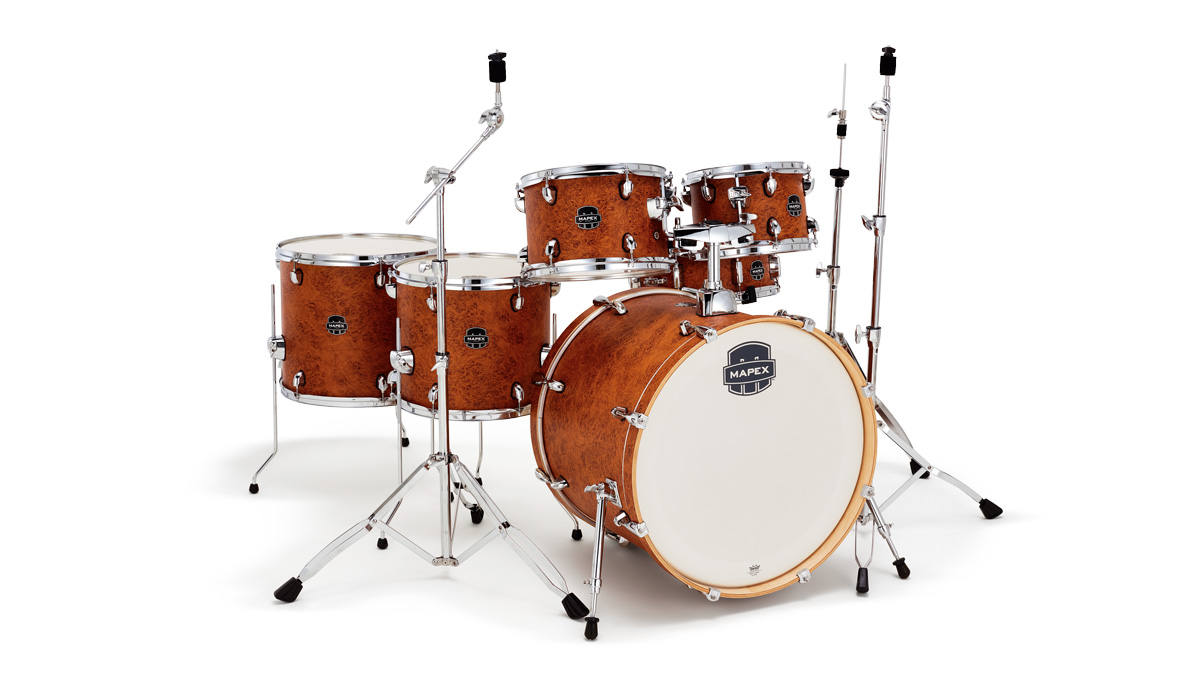MusicRadar Verdict
Despite inevitable cost-cutting in some parts, Mapex’s new Storm is an exciting prospect for first or second-time buyers.
Pros
- +
Excellent value.
- +
Option to add cymbals is welcome.
Cons
- -
Some minor finish issues.
- -
Would have liked more than 12 lugs on the floor toms.
MusicRadar's got your back
The all-new Storm replaces Mapex’s Horizon HX series.
There is a choice of 20" Fusion or 22" Rock five-piece shell packs, with a complete set of new Storm hardware and the option of a cut-price Paiste cymbal set. A second floor tom is presently included for free until roughly the end of June, depending on stock reserves.
Build
Tornado is Mapex’s basic starter kit, while Mars fills the up-market budget slot with its birch shells. The new Storm slips in-between, a superior starter kit with hardware included. The striking vision you see on these pages is the Rock Fusion set: 22"x18", 10"x7", 12"x8", 16"x14" and 14"x5" snare, plus a ‘free’ 14"x12" floor tom, a full set of hardware and optional Paiste cymbal set.
There are four Storm finishes, but the stand-out one is sported by the review kit, a wrap covering called Camphor. In the past this might have been cheesy (Premier’s infamous 1960s ‘Mahogany’ Duroplastic comes to mind), but this is really convincing. Only on close inspection do you grasp that it’s not a top-end burl veneer.

There are three other finishes - Ebony Blue Grain, Textured Iron Grey and Textured Deep Black, the latter two with Black Plate hardware rather than chrome.
Shells are poplar, an inexpensive hardwood which has long been used in drum building, though more often as a filler as it is unremarkable looking. As is usual with budget kits the shells are quite thick (7.2mm), with multiple (eight) plies. This is simply because the wood is not as tough as top grade lumber.
Having said that, the inner finish is good and here’s the clincher: the shells are precisely round. All the more impressive since the poplar is comparatively soft, and looking closely at the bearing edges you can see the porous, fibrous nature of the wood. This is not a big problem as Mapex makes its own shells and has laid up the plies so that the crucial peak of the edge lies on a horizontal ply, which has a smooth, hard edge.
Lugs are the familiar Mapex-family small shield shape, dapper with isolating black gaskets. As is normal with cheaper kits there are just 16 lugs on the 22" bass drum and 12 on the toms. This is fine except 12 is the absolute minimum practical number once you get to the 16" tom. The snare has a different design of lug, eight of a squared double-ended shape which curiously don’t really match.
The snare throw-off is a perfunctory generic device with a side lever operation that does not click into place too convincingly. The steel hoops, pressed steel bass drum claws and snare strainer are thinly chromed and not polished too well, but this is likely another consequence of budget drum kits being offered so cheaply.

The chrome on some other fittings and the stands/hardware, where there is a larger expanse of metal, is better. For example, the sturdy bass drum tom mount gleams.
The two small toms are mounted via ‘L’ arm rods which have a hexagonal cross-section preventing rotational slippage. They are locked into the bass drum mount with a smart black plastic gripper so that, without having to overtighten, everything feels secure. Plus there’s a large memory lock on the mount so your toms can’t sink.
The bass drum spurs are again basic but do the job. Duncan Williams of Mapex’s UK distributor Korg explains, “The spurs rolled over from the previous Horizon series as there was no functional need to update their tried-and-tested design. Many Storm fittings have been directly dropped down from the Mars series.
“This includes the lugs, tom holder, floor tom brackets and legs. Sharing the parts in this way allowed us to keep the use of pressed steel fittings on the Storm series to a minimum, pretty much limited to the claws and the hoops, despite keeping the range within an upper entry-level price-point.”
As a potential starter kit, the Storm package includes a complete 400 series hardware set, originally released in 2016, and replacing the previous 500 series. There’s a snare stand, straight and boom cymbal stands, hi-hat and bass pedals. The stand-out feature is the attractive concave sweep of the double-braced legs, previously seen on the Mars and Armory series.
The stand bases are imposingly heavy duty, while the top sections are less so. For example, the snare basket has thin arms, though adequate for all but the most brutal player. The boom cymbal stand has three height-adjustable sections.
Mapex has given considerable thought to its bass drum pedal which has a shortened, hinged heel plate, so you almost get a longboard but with a heel pivot too. There’s a solid single chain, circular cam drive with a full stabilising base-plate and good adjustability. Ditto the hi-hat pedal.
Hands on
The Storm shells have Mapex’s SONIClear bearing edges which are rounded to the outside. This affords greater contact with the head - vintage-style, which is a growing trend.
The poplar is so fibrous it’s impossible to cut really sharp and hard bearing edges anyway, but they are level and as noted above the shells are impressively round. The increased head contact afforded by the edges means the attack is softened a little and the tone warmed, which is no bad thing. Fitted with clear Remo UX (Chinese budget) heads the floor toms and bass drum have volume to spare and with the SONIClear edges tune pretty easily.
Mounting the small toms involves old-style fixed brackets (not ISO brackets) and a double bass-drum mount. Personally, we’re fine with this - it controls and tempers the sound a bit, reining in the big bass drum.
At the same time it integrates the toms and bass drum more closely, giving a more blended character. And the proof is in the pudding. The 10" and 12" top toms fairly blammed with a really good fat tone and fresh attack.
Turning now to the 14"x5" snare, it is hard to make a great snare drum for a budget kit. It’s nearly always the weak link. The shell wood and the metal fittings here are all basic and light so that the whole drum weighs next to nothing, feeling insubstantial.
Mapex has given considerable thought to its bass drum pedal which has a shortened, hinged heel plate, so you almost get a longboard but with a heel pivot too
The snare sound is crisp enough, but in a rather characterless way, parchment-y dry and crunchy. For some reason the hoops pull low down over the batter head so that the rim-shot clearance is lower than usual. The result is a cross-stick sound that is thin and rather feeble. However, the shallow, low-profile rim-shots ring out well enough.
Finally, what about those cymbals? There’s the option to include a bargain set of brass Paiste 101 Specials, 13", 16" and 20". Paiste has the knack of turning out budget cymbals that don’t make your toes curl. And as brass goes these 101s are surprisingly civilised.
The hats have good stick definition and clicky response. Opened up they are clean, not that powerful, but pleasant. The 16" crash is abrupt, severely lacking in sustain, but again the tone is smooth.
You could use this as an effects cymbal along with a professional set of cymbals. Not so with the ride, which also has a clear stick response, but the actual ride tone is, well, brassy. The large bell is powerful with a better sound. For such a cheap set this is pretty cool.
“We were arguing a lot and we were miserable”: How Green Day exceeded expectations with their most ambitious song
"There’s plenty for us guitarists to learn – and ‘less is more’ is the overriding lesson": how to play like George Harrison on The Beatles' Abbey Road
“They didn’t like Prince’s bikini underwear”: Prince’s support sets for the The Rolling Stones in 1981 are remembered as disastrous, but guitarist Dez Dickerson says that the the crowd reaction wasn’t as bad as people think










